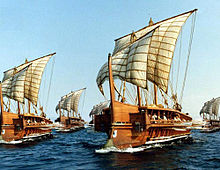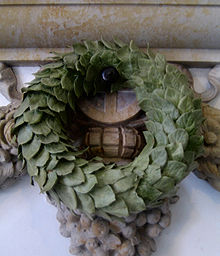|
Greek City of Elaia in Asia Minor
Bronze 17mm (4.72 grams) Struck circa 340-300 B.C.
Reference: Sear 4202; Mionnet III, 85; Weber 5548; SNG Copenhagen 889-90
Prow of galley to right.
EΛAI within laurel-wreath.
A coastal town situated south-west of Pergamon, Elaia served
as a port for its more important neighbor during the time of the Pergamene
Kingdom.
You are bidding on the exact item pictured,
provided with a Certificate of Authenticity and Lifetime Guarantee of
Authenticity.
 A A
galley is a type
of
ship propelled by
rowers that originated in the eastern
Mediterranean Sea and was used for
warfare,
trade and
piracy from the first millennium BC. Galleys
dominated
naval warfare in the Mediterranean from the 8th
century BC until development of advanced sailing warships in the 17th century.
Galleys fought in the wars of
Assyria, ancient
Phoenicia,
Greece,
Carthage and
Rome until the 4th century AD. After the fall
of the
Western Roman Empire galleys formed the
mainstay of the
Byzantine navy and other navies of successors
of the Roman Empire, as well as new
Muslim navies. Medieval Mediterranean states,
notably the Italian maritime republics, including
Venice,
Pisa,
Genoa and the
Ottoman Empire relied on them as the primary
warships of their fleets until the 17th century, when they were gradually
replaced by sailing warships. Galleys continued to be applied in minor roles in
the Mediterranean and the
Baltic Sea even after the introduction of
steam propelled ships in the early 19th
century.
The galley engagements at
Actium and
Lepanto are among the greatest
naval battles in history.
A
laurel wreath
is a circular
wreath made of interlocking branches and leaves
of the
bay laurel (Laurus nobilis,
Lauraceae), an aromatic broadleaf evergreen. In
Greek mythology,
Apollo is represented wearing a laurel wreath
on his head. In
ancient Greece wreaths were awarded to
victors, both in athletic competitions, including the ancient
Olympics made of wild olive-tree known as “kotinos”
(κότινος), (sc. at
Olympia) and in poetic meets; in
Rome they were symbols of martial victory,
crowning a successful commander during his
triumph. Whereas ancient laurel wreaths are
most often depicted as a
horseshoe shape, modern versions are usually
complete rings.
In common modern
idiomatic usage it refers to a victory. The
expression “resting on one’s laurels” refers to someone relying entirely on
long-past successes for continued fame or recognition, where to “look to one’s
laurels” encourages an individual to take inspiration from past achievements to
conquer a fresh task.
Elaea or Elaia (Greek:
Έλαία) was an ancient city of
Aeolis,
Asia, the port of
Pergamum; the site is not precisely determined but is near
Zeytindağ,
İzmir Province,
Turkey.
According to the present text of
Stephanus of Byzantium, it was also called Cidaenis (Greek: Κιδαινίς),
and was founded by
Menestheus;
but it seems likely that there is some error in the reading Cidaenis.[1]
Strabo places
Elaea south of the river
Caicus, 12 stadia from the river, and 120 stadia from Pergamum. The Caicus
enters a bay, which was called
Elaiticus Sinus, or the bay of Elaea. Strabo calls the bay of Elaea part of
the bay of
Adramyttium, but incorrectly. He has the story, which Stephanus has taken
from him, that Elaea was a settlement made by Menestheus and the
Athenians with
him, who joined the war against Troy; but Strabo does not explain how it could
be an
Aeolian
city, if this story was true. Elaea minted coins, which bear the head and name
of Menestheus. Some argue that these are some evidence of its Athenian origin;
but others, including
William Smith discount the connection.
Herodotus
(i. 149) does not name Elaea among the Aeolian cities. Strabo makes the bay of
Elaea terminate on one side in a point called Hydra, and on the other in a
promontory Harmatus; and he estimates the width between these points at 80
stadia.
Thucydides (viii. 101) places Harmatus opposite to Methymna, from which, and
the rest of the narrative, it is clear that he fixes Harmatus in a different
place from Strabo. The exact site of Elaea seems to be uncertain.
William Martin Leake, in his map, fixes it at a place marked Kliseli, on the
road from the south to Pergamum.
Scylax (p. 35),
Pomponius Mela (i. 18),
Pliny (v. 32), and
Ptolemy (v.
2), all of whom mention Elaea, do not help us to the precise place; all we learn
from them is, that the Caicus flowed between
Pitane and
Elaea.
Elaea was located near the modern town of Zeytindağ, according to the
Barrington Atlas of the Greek and Roman World.
The name of Elaea occurs in the history of the kings of Pergamum. According
to Strabo, from
Livy
(xxxv. 13), travellers who would reach Pergamum from the sea, would land at
Elaea.[2]
One of the passages of Livy shows that there was a small hill (tumulus) near
Elaea, and that the town was in a plain and walled. Elaea was damaged by an
earthquake in the reign of
Trajan, at the
same time that Pitane suffered.
|





 A
A



